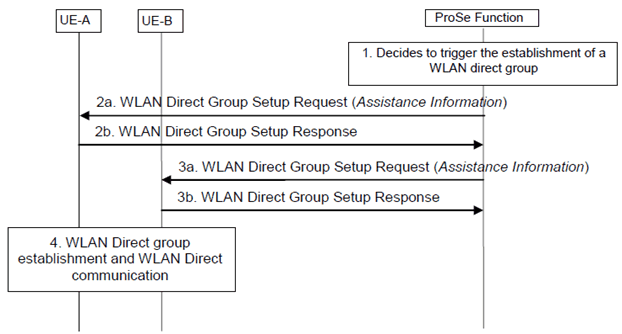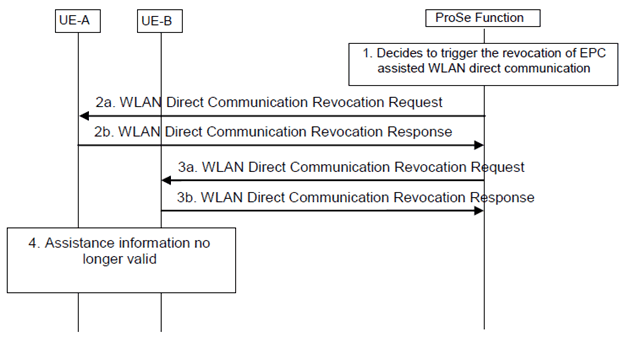Content for TS 23.303 Word version: 18.0.0
5.6 EPC support for WLAN direct discovery and communication
5.6.1 General
5.6.2 Enabling of EPC assisted WLAN direct communication
5.6.3 Revocation of EPC assisted WLAN direct communication
...
...
5.6 EPC support for WLAN direct discovery and communication p. 120
5.6.1 General p. 120
The EPC network may decide to enable two or more ProSe-enabled WLAN-capable UEs to directly communicate using WLAN technology. This decision can be taken, for example, when the EPC network supports EPC-level ProSe discovery and becomes aware that two or more UEs are in close proximity, when the EPC network knows that UE-A requests to communicate with UE-B which is in close proximity of UE-A, etc.
5.6.2 Enabling of EPC assisted WLAN direct communication p. 120
Figure 5.6.2-1 shows how the EPC network enables UE-A and UE-B to directly communicate in WLAN direct mode. This is accomplished by triggering the two UEs to establish a WLAN direct group and providing them with assistance information which enables the EPC network to control and to expedite the establishment of the WLAN direct group.
With the procedure shown in Figure 5.6.2-1 the EPC network can (i) control when a WLAN direct group can be established, (ii) authorize the UEs that can become members of this group (and thus communicate with each other in WLAN direct mode) and (iii) control the operating parameters of the WLAN direct group e.g. the SSID, the security keys, etc.
The ProSe Function shown in Figure 5.6.2-1 is the network function that triggers and controls the establishment of a WLAN direct group between one or more UEs.

Figure 5.6.2-1: Signalling flow for EPC support for WLAN direct communication
(⇒ copy of original 3GPP image)
(⇒ copy of original 3GPP image)
Step 1.
The ProSe Function decides to trigger UE-A and UE-B to establish a WLAN direct group under the control of the network.
Step 2.
The ProSe Function sends a WLAN Direct Group Setup Request (Assistance Information) to UE-A. The Assistance Information is a set of parameters which can expedite the establishment of the WLAN direct group and enables the EPC network to control the operating parameters of the WLAN direct group. The Assistance Information content depends on the WLAN technology. If UE-A accepts the request and the offered Assistance Information, it responds with a WLAN Direct Group Setup Response. This response may include parameters for the WLAN direct group proposed by UE-A (e.g. an operating channel).
Step 3.
The ProSe Function sends also a WLAN Direct Group Setup Request (Assistance Information) to UE-B. The Assistance Information in the request may take into account the parameters proposed by UE-A in step 2b.
Step 4.
The two UEs establish a WLAN direct group and may start communicating in WLAN direct mode.
5.6.3 Revocation of EPC assisted WLAN direct communication p. 121
At any time the ProSe Function may decide to revoke the EPC assisted WLAN direct communication as shown in Figure 5.6.3-1.

Figure 5.6.3-1: Signalling flow for Revocation of EPC assisted WLAN direct communication
(⇒ copy of original 3GPP image)
(⇒ copy of original 3GPP image)
Step 1.
The ProSe Function decides to revoke EPC assisted WLAN direct communication for UE-A and UE-B.
Step 2a.
The ProSe Function sends a WLAN Direct Communication Revocation Request to the UE-A.
Step 2b.
The UE-A accepts the request.
Step 3a.
The ProSe Function sends a WLAN Direct Communication Revocation Request (Control Information) to the UE-B.
Step 3b.
The UE-B accepts the request.
Step 4.
The EPC assisted WLAN direct communication Assistance Information is no longer valid and the EPC assisted WLAN direct communications using the EPC Assistance Information are released.